
Use the attached resources to research careers associated with this career cluster.
- Subject:
- Agriculture, Food and Natural Resources
- Career and Technical Education
- Material Type:
- Other
- Author:
- CESA 8
- Date Added:
- 06/29/2022

Use the attached resources to research careers associated with this career cluster.

Featuring career information from Kyle Much, Agronomist with Knutzen Crop Consulting

In this lesson, students are taught to use the Haiku format as a way to solidify the theme of their paper. First students learn about the traditional Haiku structure, and then use the structure to reflect on the cohesiveness of the main ideas in a paper they have written.
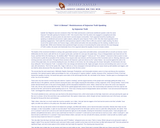
Isabelle Van Wagenen was born enslaved in New York State and became a well-known abolitionist speaker under the name Sojourner Truth after gaining her freedom in 1827. She moved to New York City where she engaged in evangelical and other reform activities; at various points she also lived in several utopian communities. Truth supported herself by traveling and speaking on abolitionist and women's rights subjects, taking the name Sojourner Truth in 1843. She often faced opposition at her speaking engagements. Truth made this extemporaneous speech in Akron Ohio in 1851 at a women's rights meeting. No direct record of the speech exists, but Frances Gage, a white activist and author who was presiding over the meeting, recalled it over a decade later. While some historians have questioned Gage's accuracy in reconstructing the syntax and even the exact language of Truth's oration, the power and charismatic force of her argument about the equality of women remains evident.
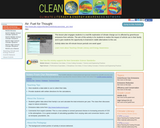
This lesson plan engages students in a real-life exploration of climate change as it is affected by greenhouse emissions from vehicles. The aim of this activity is for students to realize the impact of vehicle use in their family and to give students the opportunity to brainstorm viable alternatives to this use.

This is a series of activities demonstrating that air has mass, takes up space, and can exert a force on objects enough to lift them.

By watching and performing several simple experiments, students develop an understanding of the properties of air: it has mass, it takes up space, it can move, it exerts pressure, it can do work.
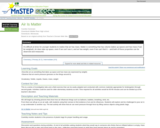
This is a series of investigations about air and its properties. How air exists all around us, and things it is capable of doing.
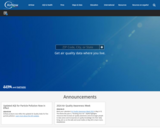
AirNow is your one-stop source for air quality data. Our recently redesigned site highlights air quality in your local area first, while still providing air quality information at state, national, and world views. A new interactive map even lets you zoom out to get the big picture or drill down to see data for a single air quality monitor.
AirNow reports air quality using the official U.S. Air Quality Index (AQI), a color-coded index designed to communicate whether air quality is healthy or unhealthy for you. When you know the AQI in your area, you can take steps to protect your health.
AirNow is a partnership of the U.S. Environmental Protection Agency, National Oceanic and Atmospheric Administration (NOAA), National Park Service, NASA, Centers for Disease Control, and tribal, state, and local air quality agencies. Complete list of AirNow partners. Agencies all over the country send their monitoring data to AirNow for display. The Department of State provides data from U.S. Embassies and Consulates to inform personnel and citizens overseas, and the U.S. Forest Service and NOAA provide fire and smoke data.
AirNow’s centralized data system provides quality control, national reporting consistency, and the ability to distribute data to the public, researchers, businesses, educators, and to other data systems. In AirNow, you’ll find:
Current and forecast air quality maps and data for more than 500 cities across the U.S.
Current and historical data for U.S. Embassies and Consulates around the world
Current fire conditions including fire locations, smoke plumes, and air quality data from permanent and temporary air quality monitors
Air quality data for Canada and Mexico
Enviroflash emails, apps, widgets, and an API
Health and air quality information for
the public
healthcare professionals
teachers and students
weathercasters

The Phoenix metropolitan area, like many large cities, has problems with air pollution at certain times of the year. You can do a simple experiment to determine some of the factors that affect air pollution.
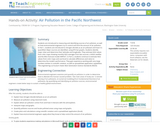
Students are introduced to measuring and identifying sources of air pollution, as well as how environmental engineers try to control and limit the amount of air pollution. In Part 1, students are introduced to nitrogen dioxide as an air pollutant and how it is quantified. Major sources are identified, using EPA bar graphs. Students identify major cities and determine their latitudes and longitudes. They estimate NO2 values from color maps showing monthly NO2 averages from two sources: a NASA satellite and the WSU forecast model AIRPACT. In Part 2, students continue to estimate NO2 values from color maps and use Excel to calculate differences and ratios to determine the model's performance. They gain experience working with very large numbers written in scientific notation, as well as spreadsheet application capabilities.
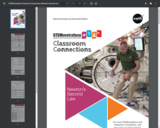
Students will test how an equal force impacts an object’s acceleration as its mass increases. They will make a paper car that uses wind power (air pump) to propel forward. The car will ride along a track made from straws to simulate motion in one dimension. They will repeat these steps for multiple trials while adding mass each time. By collecting and recording data, students should notice a trend, and use their data to prove Newton’s Second Law of Motion. Extensions include making adaptations to the car, or even generating an entirely new design, while comparing their results to the first design.
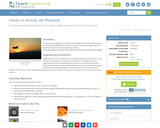
Air pressure is pushing on us all the time although we do not usually notice it. In this activity, students learn about the units of pressure and get a sense of just how much air pressure is pushing on them.

K-2 Air Pressure Physical Science Experiment
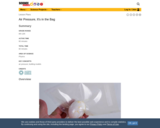
This is a lesson where students are asked to create a change in air pressure using a garbage bag and a vacuum cleaner. They are then asked to create an illustration, model or concept map explaining what is happening.
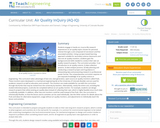
Students engage in hands-on, true-to-life research experiences on air quality topics chosen for personal interest through a unit composed of one lesson and five associated activities. Using a project-based learning approach suitable for secondary science classrooms and low-cost air quality monitors, students gain the background and skills needed to conduct their own air quality research projects. The curriculum provides: 1) an introduction to air quality science, 2) data collection practice, 3) data analysis practice, 4) help planning and conducting a research project and 5) guidance in interpreting data and presenting research in professional poster format. The comprehensive curriculum requires no pre-requisite knowledge of air quality science or engineering. This curriculum takes advantage of low-cost, next-generation, open-source air quality monitors called Pods. These monitors were developed in a mechanical engineering lab at the University of Colorado Boulder and are used for academic research as well as education and outreach. The monitors are made available for use with this curriculum through AQ-IQ Kits that may be rented from the university by teachers. Alternatively, nearly the entire unit, including the student-directed projects, could also be completed without an air quality monitor. For example, students can design research projects that utilize existing air quality data instead of collecting their own, which is highly feasible since much data is publically available. In addition, other low-cost monitors could be used instead of the Pods. Also, the curriculum is intentionally flexible, so that the lesson and its activities can be used individually. See the Other section for details about the Pods and ideas for alternative equipment, usage without air quality monitors, and adjustments to individually teach the lesson and activities.
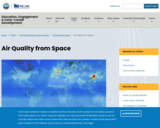
This resource is for students and educators who want to learn about how satellites can collect data on Earth’s air pollution and greenhouse gas levels from space.This is a lecture video from NSF NCAR Scientist and Associate Director Dr. Pieternel Levelt.
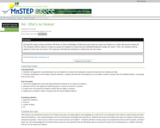
This is an inquiry activity that relies of pervious understanding of balancing and weighing to introduce a properties of air.
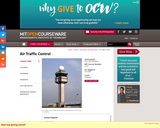
Introduces the various aspects of present and future Air Traffic Control systems. Descriptions of the present system: systems-analysis approach to problems of capacity and safety; surveillance, including NAS and ARTS; navigation subsystem technology; aircraft guidance and control; communications; collision avoidance systems; sequencing and spacing in terminal areas; future directions and development; critical discussion of past proposals and of probable future problem areas.
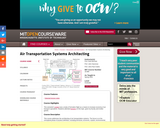
Subject addresses the architecting of air transportation systems. Focuses on the conceptual phase of product definition include technical, economic, market, environmental, regulatory, legal, manufacturing, and societal factors. Subject centers on a realistic system case study and includes a number of lectures from industry and government. Past examples included the Very Large Transport Aircraft, a Supersonic Business Jet and a Next Generation Cargo System. Subject identifies the critical system level issues and analyzes them in depth via student team projects and individual assignments. The overall goal of the semester is to produce a business plan and a system specifications document that can be used to assess candidate systems.